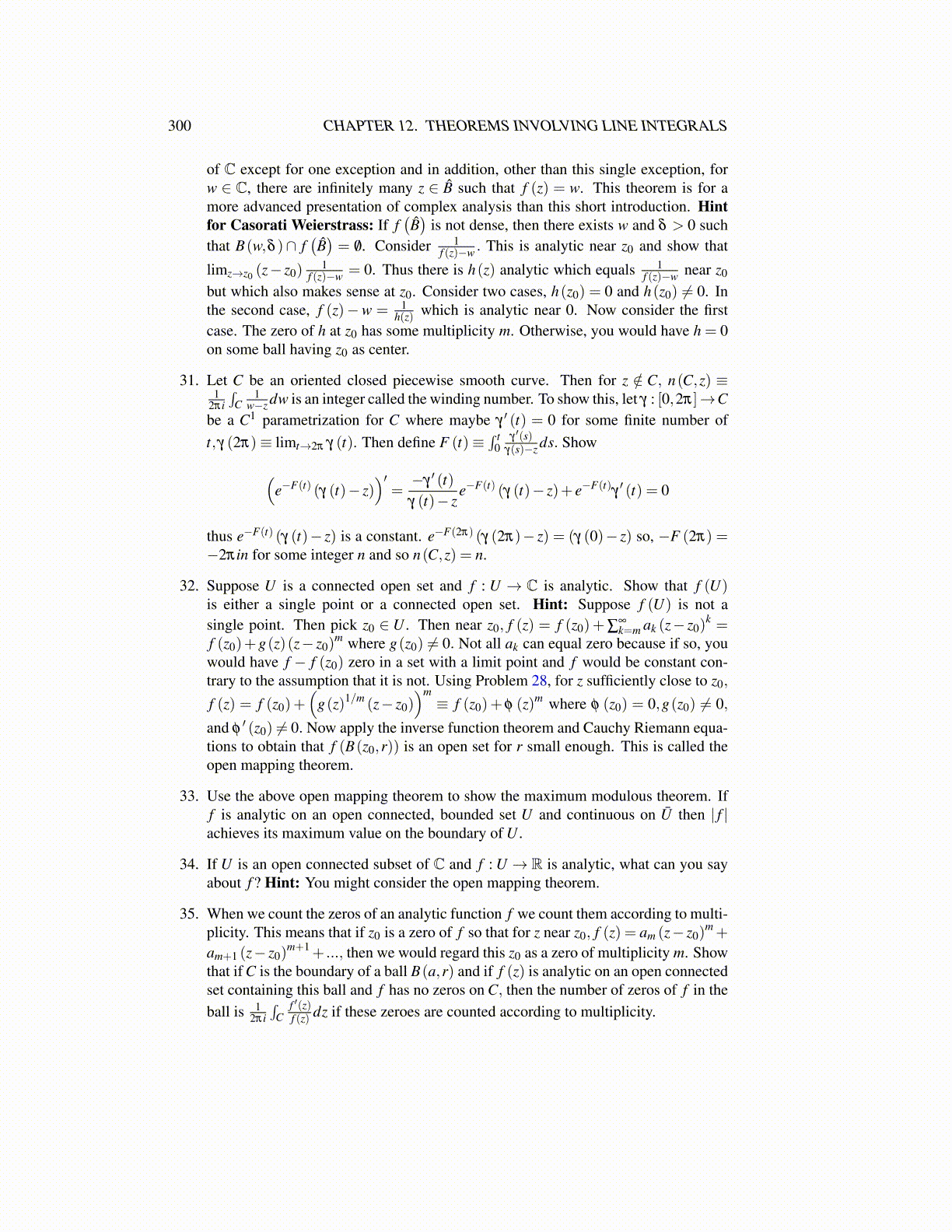
300 CHAPTER 12. THEOREMS INVOLVING LINE INTEGRALS
of C except for one exception and in addition, other than this single exception, forw ∈ C, there are infinitely many z ∈ B̂ such that f (z) = w. This theorem is for amore advanced presentation of complex analysis than this short introduction. Hintfor Casorati Weierstrass: If f
(B̂)
is not dense, then there exists w and δ > 0 suchthat B(w,δ )∩ f
(B̂)= /0. Consider 1
f (z)−w . This is analytic near z0 and show that
limz→z0 (z− z0)1
f (z)−w = 0. Thus there is h(z) analytic which equals 1f (z)−w near z0
but which also makes sense at z0. Consider two cases, h(z0) = 0 and h(z0) ̸= 0. Inthe second case, f (z)−w = 1
h(z) which is analytic near 0. Now consider the firstcase. The zero of h at z0 has some multiplicity m. Otherwise, you would have h = 0on some ball having z0 as center.
31. Let C be an oriented closed piecewise smooth curve. Then for z /∈ C, n(C,z) ≡1
2πi∫
C1
w−z dw is an integer called the winding number. To show this, let γ : [0,2π]→Cbe a C1 parametrization for C where maybe γ ′ (t) = 0 for some finite number oft,γ (2π)≡ limt→2π γ (t). Then define F (t)≡
∫ t0
γ ′(s)γ(s)−z ds. Show
(e−F(t) (γ (t)− z)
)′=−γ ′ (t)γ (t)− z
e−F(t) (γ (t)− z)+ e−F(t)γ′ (t) = 0
thus e−F(t) (γ (t)− z) is a constant. e−F(2π) (γ (2π)− z) = (γ (0)− z) so, −F (2π) =−2πin for some integer n and so n(C,z) = n.
32. Suppose U is a connected open set and f : U → C is analytic. Show that f (U)is either a single point or a connected open set. Hint: Suppose f (U) is not asingle point. Then pick z0 ∈ U . Then near z0, f (z) = f (z0)+∑
∞k=m ak (z− z0)
k =f (z0)+g(z)(z− z0)
m where g(z0) ̸= 0. Not all ak can equal zero because if so, youwould have f − f (z0) zero in a set with a limit point and f would be constant con-trary to the assumption that it is not. Using Problem 28, for z sufficiently close to z0,
f (z) = f (z0)+(
g(z)1/m (z− z0))m≡ f (z0)+ φ (z)m where φ (z0) = 0,g(z0) ̸= 0,
and φ′ (z0) ̸= 0. Now apply the inverse function theorem and Cauchy Riemann equa-
tions to obtain that f (B(z0,r)) is an open set for r small enough. This is called theopen mapping theorem.
33. Use the above open mapping theorem to show the maximum modulous theorem. Iff is analytic on an open connected, bounded set U and continuous on Ū then | f |achieves its maximum value on the boundary of U .
34. If U is an open connected subset of C and f : U → R is analytic, what can you sayabout f ? Hint: You might consider the open mapping theorem.
35. When we count the zeros of an analytic function f we count them according to multi-plicity. This means that if z0 is a zero of f so that for z near z0, f (z) = am (z− z0)
m +
am+1 (z− z0)m+1+ ..., then we would regard this z0 as a zero of multiplicity m. Show
that if C is the boundary of a ball B(a,r) and if f (z) is analytic on an open connectedset containing this ball and f has no zeros on C, then the number of zeros of f in theball is 1
2πi∫
Cf ′(z)f (z) dz if these zeroes are counted according to multiplicity.